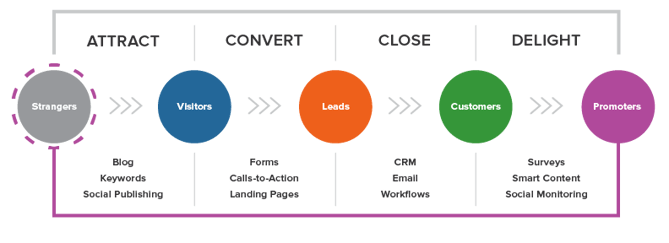Written by Amanda Zantal-Wiener
In marketing, it seems like the word “brand” is used a lot — the leading brand, off-brand, personal brand … you get the picture.
But there’s often confusion around its meaning in business. What does it entail? Do I need to hire an expert? Branding is expensive, right?
To that very last point, it doesn’t have to be. As it turns out, there are some pretty creative ways to brand your business without a ton of cash. And while it can require an investment of time, the ROI won’t go unnoticed — in some cases, it can actually help you save money.

So read on, and see how you can start building a brand today.
How to Brand Your Business on a Budget: A 6-Step Guide
1) Know your personas.
It’s no coincidence that 82% of companies with better value propositions also use buyer personas — the semi-fictional “characters” that encompass the qualities of who you’re trying to reach.
The needs, goals, and behavior of your potential customers dictate how you convey your product or service. Understanding those things helps you determine what kind of media your personas are consuming, what motivates them, and where they “live” online. You can see why having that information helps develop a compelling, effective brand — it helps you reach the right people.
2) Develop an identity and a voice.
Once you’ve identified your buyer personas, your brand can start to take shape. That involves creating a brand identity — the things that make people aware of what your brand is — and its voice, which is the tone you use in any copy or public communication.
But instead of answering questions about your target audience, you’re answering questions that are a bit more introspective to your brand. What are its values? What does it represent? How do you want people to talk about you?
Even if you’re not starting from scratch, establishing a strong(er) brand voice can be valuable. Just take the instance of the Zoological Wildlife Foundation — during its recent rebrand, finding its voice was a top priority.
3) Have a consistent social media presence.
So, we know who your personas are. And now, we know what to say to them — and how to say it. But where are they?
Since you might have a clear picture of the different pieces of your audience, it’s important to figure out where they’re spending the most time, especially on social media.
Pay attention close attention to the data. Maybe the majority of your personas spend most of their time on one network. While that doesn’t mean you should ignore the others, it does give you an idea of where to dedicate the most resources.
And once you do establish that presence, maintain it. How many times have you gone to a brand’s Facebook Page only to find that nothing has been posted in the past three months? Chances are, it didn’t have a positive impact on your perception.
That can be avoided by diligently planning and scheduling social media posts like you would with any other marketing calendar.
4) Blog.
We’ve covered the importance of blogging before, and we really can’t emphasize it enough. It’s a core part of our Inbound Methodology, especially the “attract” stage — the one that turns strangers into visitors to your website.


In fact, blogging might be the most fundamental step of inbound marketing. It helps you reach qualified customers, like your personas, by creating the informative content that matches the information they’re searching for. That’s why it’s so important to make it relevant to this audience — when you’re writing, make sure the content is optimized for those searches.
Believe us — your personas are definitely looking for the information that you’re able to provide — if you write about it. After friends and family, blogs are the third most trusted source of information. Plus, that content will also serve as material to populate your social media networks, and we’ve already covered what a crucial part that plays in branding on a budget.
While blogging is fiscally inexpensive, one of the biggest struggles we hear about is the cost of spending time on it. For that, we reference the joke about a doctor asking his patient, “Would you rather work out one hour per day, or be dead 24 hours per day?” The inbound marketing version of that question would ask, “Would you rather blog for one hour each day, or always have insufficient content to draw in visitors?”
Like planning your social media presence, having an editorial calendar for your blog can be helpful in maintaining consistent timing and fresh content.
5) Make customer service a priority.
When we hear the name “Zappos,” most of us immediately think, “unparalleled customer service.” The online apparel retailer built this level of service into its core approach to doing business — and into its core values.
Why is that so important? For Zappos, making excellent customer service the cornerstone of its brand actually saved money on marketing and advertising. That’s because it created word-of-mouth among existing and potential customers, which is what we call earned media — the recognition that your brand has earned, not paid for, from people talking about something remarkable you did. (Psst — U.S. businesses, as a whole, lose about $41 billion dollars each year because of bad customer service.)
Whether you’re serving customers or clients, the goal is to create a delightful, sharable experience. And when the client or customer experience is a priority, it shouldn’t cost you much for them to talk about it — remember, your work earned it.
But that revisits the importance of your identity and voice. As you go through these brand-building steps, think about the values that you want to be resonated in those things. Is excellent service one of them? Those values are what shape the brand’s culture, and that influences the voice you project to an audience.
6) Take advantage of co-branding.
I’ll never forget what my colleague Lisa Toner told me when I asked her about negotiating co-branding agreements.
“Larger companies may have a large reach,” she said, “but what do they not have?”
When you’re just starting to build a brand, you might not have the reach that Toner’s talking about. You can take the steps to build it, like we’ve described so far, but that takes time. Until then, one way to get your name in front of a broader audience is to partner with a brand that has one.
But don’t just pick any old brand to work with. Make sure it’s one that’s aligned with yours — the partnership has to make sense in the minds of your audience. Here’s what we recommend in seeking a co-brand:
- Consider your partner’s audience. Would it be interested in your brand? Is it that difficult for you to reach without this partnership? How well does it trust your co-brand? That’s crucial to getting them to listen to you, too — people don’t trust traditional advertisements anymore. So make sure your partner reaches the audience in a way that instills confidence, not doubt.
- Have something to offer your co-brand. Just like Toner asked, “what do they not have?” The experience should be a win-win-win: for you, your co-brand, and the consumer.
- Consider selecting a well-known and respected nonprofit as a co-brand. More and more people’s purchasing decisions are based on a brand’s social responsibility — in fact, 85% of millennials say that makes them more willing to recommend a brand.
Get Branding
Building a brand might seem like a huge undertaking, especially when resources are limited. But as we’ve seen, there are plenty of economical ways to not only get started, but to continue the momentum you start with these efforts.
And please, have fun with the process. Of course, there has to be a degree of strategy and logic involved — that’s why we’ve built the tools to help you determine what the different pieces of your brand will be. But it’s a creative exercise, so keep that in mind if you get bogged down in technicalities.
Related Tag: Brand Strategy Sydney
